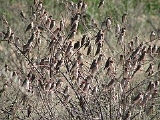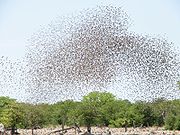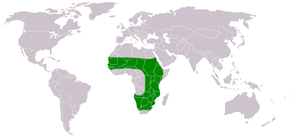
Red-billed Quelea
Encyclopedia
The Red-billed Quelea (Quelea quelea) is the world's most abundant wild bird
species, with an estimated adult breeding population of 1.5 billion pairs. Some estimates of the overall population have been as large as 10 billion. It is a small passerine
bird of the weaver family Ploceidae, native to sub-Saharan Africa
.
 Red-billed Quelea grow to 11–13 cm (4.3-5.1 in) long and a weight of 15 to 20 g
Red-billed Quelea grow to 11–13 cm (4.3-5.1 in) long and a weight of 15 to 20 g
(0.5-0.7 oz). During breeding the male is distinguished by its more colorful plumage and red bill. Breeding plumage in male queleas is unusually variable: comprising a facial mask which ranges from black to white in color, and breast and crown plumage which varies from yellowish to bright red. For the rest of the year male plumage resembles that of the female, which is a cryptic beige coloration. The female's bill is yellow during breeding, and red during the non-breeding season.
which can take up to 5 hours to fly past. They live mostly in steppe
and savanna
regions, but do not avoid human settlements. While foraging for food they may fly large distances each day without tiring. Their life expectancy is two to three years.
s from grass
and straw
. After the female has examined the construction and the mating has occurred, both partners complete the weaving of the nest. The female lays two to four light blue egg
s, and incubates them for twelve days. After the chicks hatch, they are nourished for some days with caterpillar
s and protein
-rich insect
s. After this time parents change to mainly feeding seed
s. The young birds fledge and become independent enough to leave their parents after approximately two weeks in the nest. They are sexually mature after just one year, but many birds die before reaching this stage and males may weave nests that go unused if the female dies.
comes up, they come together in their huge flocks and co-operate in finding a suitable feeding place. After a successful search, they settle rapidly and can cause serious damage to crops. In the middle part of the day they rest in shady areas near water and preen. Birds seem to prefer drinking at least twice a day. In the evening they once again fly in search of food.
s, stork
s, raptors
, owl
s, hornbill
s, roller
s, kingfisher
s, shrike
s and corvids. Additionally, snake
s, lizard
s and several types of mammal
s, especially rodent
s and small carnivores
, are regular predators.
They are regarded as pests by farmers because they can eliminate fields in a short period of time. Due to the numbers and localized decimation of cereal crops, control actions have been undertaken. As many as 150-180 million birds have been killed but this appeared to have no effect on the overall quelea population and only temporary relief from crop damage. Unfortunately, many non-target birds appeared to have also been killed in these control operations and may have had severe population deprevations as a result.
 The distribution area of the Red-billed Quelea covers most of sub-Saharan Africa, excluding the rain forest areas and parts of South Africa
The distribution area of the Red-billed Quelea covers most of sub-Saharan Africa, excluding the rain forest areas and parts of South Africa
.
Bird
Birds are feathered, winged, bipedal, endothermic , egg-laying, vertebrate animals. Around 10,000 living species and 188 families makes them the most speciose class of tetrapod vertebrates. They inhabit ecosystems across the globe, from the Arctic to the Antarctic. Extant birds range in size from...
species, with an estimated adult breeding population of 1.5 billion pairs. Some estimates of the overall population have been as large as 10 billion. It is a small passerine
Passerine
A passerine is a bird of the order Passeriformes, which includes more than half of all bird species. Sometimes known as perching birds or, less accurately, as songbirds, the passerines form one of the most diverse terrestrial vertebrate orders: with over 5,000 identified species, it has roughly...
bird of the weaver family Ploceidae, native to sub-Saharan Africa
Sub-Saharan Africa
Sub-Saharan Africa as a geographical term refers to the area of the African continent which lies south of the Sahara. A political definition of Sub-Saharan Africa, instead, covers all African countries which are fully or partially located south of the Sahara...
.
Characteristics

Gram
The gram is a metric system unit of mass....
(0.5-0.7 oz). During breeding the male is distinguished by its more colorful plumage and red bill. Breeding plumage in male queleas is unusually variable: comprising a facial mask which ranges from black to white in color, and breast and crown plumage which varies from yellowish to bright red. For the rest of the year male plumage resembles that of the female, which is a cryptic beige coloration. The female's bill is yellow during breeding, and red during the non-breeding season.
Habits
Red-billed Quelea live and breed in huge flocksGroup size measures
Many animals, including humans, tend to live in groups, herds, flocks, bands, packs, shoals, or colonies of conspecific individuals. The size of these groups, as expressed by the number of participant individuals, is an important aspect of their social environment...
which can take up to 5 hours to fly past. They live mostly in steppe
Steppe
In physical geography, steppe is an ecoregion, in the montane grasslands and shrublands and temperate grasslands, savannas, and shrublands biomes, characterized by grassland plains without trees apart from those near rivers and lakes...
and savanna
Savanna
A savanna, or savannah, is a grassland ecosystem characterized by the trees being sufficiently small or widely spaced so that the canopy does not close. The open canopy allows sufficient light to reach the ground to support an unbroken herbaceous layer consisting primarily of C4 grasses.Some...
regions, but do not avoid human settlements. While foraging for food they may fly large distances each day without tiring. Their life expectancy is two to three years.
Origin
Origin and phylogeny has been obtained by Antonio Arnaiz-Villena et al. Estrildinae may have originated in India and dispersed thereafter (towards Africa and Pacific Ocean habitats).Reproduction
Breeding is localized and erratic but often colonies include tens of thousands to millions of pairs. The breeding season begins with the seasonal rains, which come at different times in different parts of their range - starting at the north-western edge around the beginning of November. The breeding males first weave half-complete ovoid nestBird nest
A bird nest is the spot in which a bird lays and incubates its eggs and raises its young. Although the term popularly refers to a specific structure made by the bird itself—such as the grassy cup nest of the American Robin or Eurasian Blackbird, or the elaborately woven hanging nest of the...
s from grass
Grass
Grasses, or more technically graminoids, are monocotyledonous, usually herbaceous plants with narrow leaves growing from the base. They include the "true grasses", of the Poaceae family, as well as the sedges and the rushes . The true grasses include cereals, bamboo and the grasses of lawns ...
and straw
Straw
Straw is an agricultural by-product, the dry stalks of cereal plants, after the grain and chaff have been removed. Straw makes up about half of the yield of cereal crops such as barley, oats, rice, rye and wheat. It has many uses, including fuel, livestock bedding and fodder, thatching and...
. After the female has examined the construction and the mating has occurred, both partners complete the weaving of the nest. The female lays two to four light blue egg
Egg (biology)
An egg is an organic vessel in which an embryo first begins to develop. In most birds, reptiles, insects, molluscs, fish, and monotremes, an egg is the zygote, resulting from fertilization of the ovum, which is expelled from the body and permitted to develop outside the body until the developing...
s, and incubates them for twelve days. After the chicks hatch, they are nourished for some days with caterpillar
Caterpillar
Caterpillars are the larval form of members of the order Lepidoptera . They are mostly herbivorous in food habit, although some species are insectivorous. Caterpillars are voracious feeders and many of them are considered to be pests in agriculture...
s and protein
Protein
Proteins are biochemical compounds consisting of one or more polypeptides typically folded into a globular or fibrous form, facilitating a biological function. A polypeptide is a single linear polymer chain of amino acids bonded together by peptide bonds between the carboxyl and amino groups of...
-rich insect
Insect
Insects are a class of living creatures within the arthropods that have a chitinous exoskeleton, a three-part body , three pairs of jointed legs, compound eyes, and two antennae...
s. After this time parents change to mainly feeding seed
Seed
A seed is a small embryonic plant enclosed in a covering called the seed coat, usually with some stored food. It is the product of the ripened ovule of gymnosperm and angiosperm plants which occurs after fertilization and some growth within the mother plant...
s. The young birds fledge and become independent enough to leave their parents after approximately two weeks in the nest. They are sexually mature after just one year, but many birds die before reaching this stage and males may weave nests that go unused if the female dies.
Food
The food of the Red-billed Quelea consists of annual grasses, seeds and grain. As soon as the sunSun
The Sun is the star at the center of the Solar System. It is almost perfectly spherical and consists of hot plasma interwoven with magnetic fields...
comes up, they come together in their huge flocks and co-operate in finding a suitable feeding place. After a successful search, they settle rapidly and can cause serious damage to crops. In the middle part of the day they rest in shady areas near water and preen. Birds seem to prefer drinking at least twice a day. In the evening they once again fly in search of food.
Enemies and population control
Being such a considerable part of the savanna biomass, Red-billed Quelea flocks and colonies attract huge numbers and diverse types of predators and scavengers. Birds known to live extensively off of queleas include heronHeron
The herons are long-legged freshwater and coastal birds in the family Ardeidae. There are 64 recognised species in this family. Some are called "egrets" or "bitterns" instead of "heron"....
s, stork
Stork
Storks are large, long-legged, long-necked wading birds with long, stout bills. They belong to the family Ciconiidae. They are the only family in the biological order Ciconiiformes, which was once much larger and held a number of families....
s, raptors
Accipitriformes
The Accipitriformes is an order that has been proposed to include most of the diurnal birds of prey: hawks, eagles, vultures, and many others, about 225 species in all. For a long time, the majority view has been to include them with the falcons in the Falconiformes, but some authorities have...
, owl
Owl
Owls are a group of birds that belong to the order Strigiformes, constituting 200 bird of prey species. Most are solitary and nocturnal, with some exceptions . Owls hunt mostly small mammals, insects, and other birds, although a few species specialize in hunting fish...
s, hornbill
Hornbill
Hornbills are a family of bird found in tropical and subtropical Africa, Asia and Melanesia. They are characterized by a long, down-curved bill which is frequently brightly-colored and sometimes has a casque on the upper mandible. Both the common English and the scientific name of the family...
s, roller
Roller
The rollers are an Old World family, Coraciidae, of near passerine birds. The group gets its name from the aerial acrobatics some of these birds perform during courtship or territorial flights. Rollers resemble crows in size and build, and share the colourful appearance of kingfishers and...
s, kingfisher
Kingfisher
Kingfishers are a group of small to medium sized brightly coloured birds in the order Coraciiformes. They have a cosmopolitan distribution, with most species being found in the Old World and Australia...
s, shrike
Shrike
Shrikes are passerine birds of the family Laniidae. The family is composed of thirty-one species in three genera. The family name, and that of the largest genus, Lanius, is derived from the Latin word for "butcher", and some shrikes were also known as "butcher birds" because of their feeding habits...
s and corvids. Additionally, snake
Snake
Snakes are elongate, legless, carnivorous reptiles of the suborder Serpentes that can be distinguished from legless lizards by their lack of eyelids and external ears. Like all squamates, snakes are ectothermic, amniote vertebrates covered in overlapping scales...
s, lizard
Lizard
Lizards are a widespread group of squamate reptiles, with nearly 3800 species, ranging across all continents except Antarctica as well as most oceanic island chains...
s and several types of mammal
Mammal
Mammals are members of a class of air-breathing vertebrate animals characterised by the possession of endothermy, hair, three middle ear bones, and mammary glands functional in mothers with young...
s, especially rodent
Rodent
Rodentia is an order of mammals also known as rodents, characterised by two continuously growing incisors in the upper and lower jaws which must be kept short by gnawing....
s and small carnivores
Carnivora
The diverse order Carnivora |Latin]] carō "flesh", + vorāre "to devour") includes over 260 species of placental mammals. Its members are formally referred to as carnivorans, while the word "carnivore" can refer to any meat-eating animal...
, are regular predators.
They are regarded as pests by farmers because they can eliminate fields in a short period of time. Due to the numbers and localized decimation of cereal crops, control actions have been undertaken. As many as 150-180 million birds have been killed but this appeared to have no effect on the overall quelea population and only temporary relief from crop damage. Unfortunately, many non-target birds appeared to have also been killed in these control operations and may have had severe population deprevations as a result.
Distribution

South Africa
The Republic of South Africa is a country in southern Africa. Located at the southern tip of Africa, it is divided into nine provinces, with of coastline on the Atlantic and Indian oceans...
.

